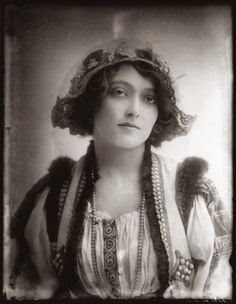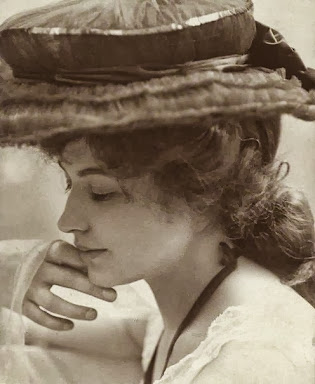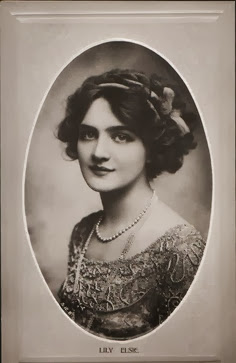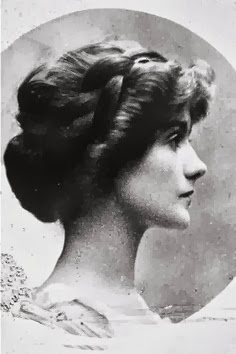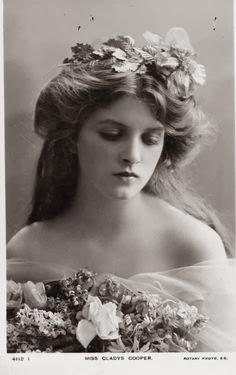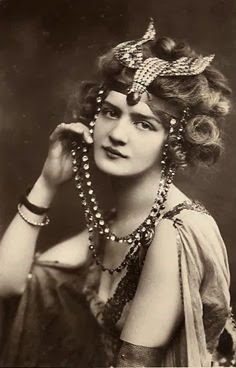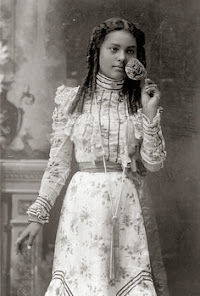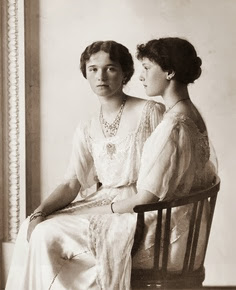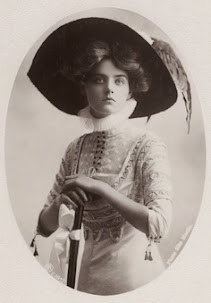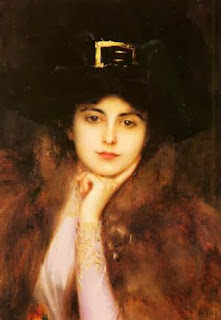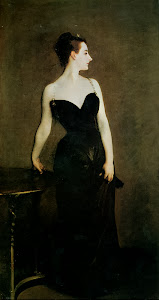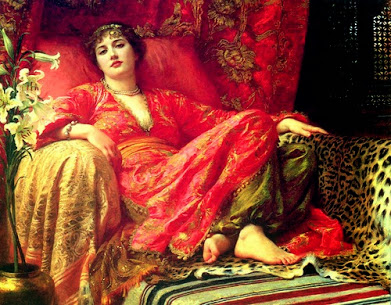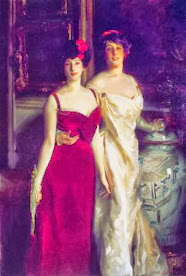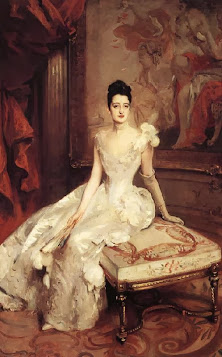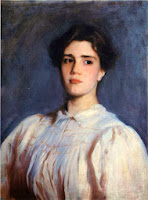 My grandmother used to give us girls beautiful old fashioned, Victorian remake-style powder boxes and candy tins with Victorian children's faces on them when we were kids, and we always loved them and still have them nowadays. Till this day I love the elegance and beauty of the women of that era. And their flawless faces.
My grandmother used to give us girls beautiful old fashioned, Victorian remake-style powder boxes and candy tins with Victorian children's faces on them when we were kids, and we always loved them and still have them nowadays. Till this day I love the elegance and beauty of the women of that era. And their flawless faces.These are also a little bit for Gunter Schröder, who wrote me he liked the old fashioned and romantic images so much :) See the properties of each picture for more information on dates and those portrayed. (Right click on the picture and select 'safe as' and you will see the information appearing as your saving title). Below, under the paintings, is more information on the ladies portrayed, all real life socialites. I always wondered if certain times had more than average amounts of women/men with a distinctive similar face type? Or if it is just looking that way because only people with that fashionable face were picked out by photographers and movie makers etc. For instance, the early 1900's/Belle Epoque era had more of the female round faces, chubby cheeks, light eyes, not much make-up, doll-like.. something hard to pinpoint. Quite different from the 20's or 60's. Guess some people have the look of a certain era, like period movies still cast extra's with the look of the 60's or 50's or whenever that movie is situated.
These are my own grandmother and -father, when she was in her late 30's. Both my grandparents are from Polish heritage
My grandmothers parents were Polish and moved to the Netherlands, here
she is with an uncle as baby; my grandfather with my mother as a young woman
My grandparents with their 6 kids, my mother being the youngest
My grandfather and his 9 (half-)siblings. In total my great-grandparents had 16
kids, but 6 died of the Spanish Flu. Grandpa had a Polish father unlike the rest of the kids
My grandparents from dads side, photo from 1938
(gran looks just like my sister on the right)



Most of these paintings were made by John Singer Sargent, and some others by his contemporaries. Sargent was an American/Italian born 'society painting' artist, who depicted the rich and aristocratic of his era and Edwardian luxury. See their portraits and read about their life stories here. (The information is gathered online (for instance from wikimedia commons) and from books
Mrs. Charles E Inches (Louise Pomeroy), 1887
Louise Pomeroy Inches (1861–1933) was born in Troy, Pennsylvania, the youngest of three daughters of Horace and Emma Pomeroy. When she was twenty-two, she married Dr. Charles Inches of Boston, a Harvard-educated physician twenty years her senior, who become known for giving free medical aid to the poor. At the time she sat for her portrait, Louise Inches was a prominent society hostess well known for her beauty and the mother of two young sons. She was pregnant with her third child when she posed for Sargent, wearing a fashionably daring red evening gown that had been made with detachable panels to accommodate her pregnancies. Apparently the artist and sitter enjoyed each other’s company; both were accomplished musicians and are said to have played piano duets together.
Lady Agnew of Lochnaw, 1893
Andrew Noel Agnew, a barrister who had inherited the baronetcy and estates of Lochnaw in Galloway, commissioned this painting of his young wife, Gertrude Vernon (1865-1932), in 1892. It was exhibited at the Royal Academy in 1898 and made Sargent's name. The sculptor Rodin described him as 'the Van Dyck of our times'. Portrait commissions poured in and Sargent enjoyed something of a cult following in Edwardian society. It also launched Lady Agnew as a society beauty.
 Wertheimer sisters, 1901
Wertheimer sisters, 1901This is one of a series of portraits Sargent was commissioned to make of the family of the art dealer Asher Wertheimer (1844–1918). The two men became friends and Wertheimer helped Sargent obtain commissions. This portrait shows Wertheimer’s eldest daughters, Helena (Ena) and Elizabeth (Betty). Sargent was much attracted by the charm of the Wertheimer family, especially the vivacity of Ena (right), something which is clearly revealed in this portrait. The different textures of the sisters’ dresses are skilfully evoked, the rich depth of Betty’s red velvet contrasting with the shine of Ena’s white damask.
Madame X, 18
Virginie Amélie Avegno Gautreau (1859–1915) was born in New Orleans but grew up from the age of eight in France. She married a French banker, and became notorious in Parisian high society for her beauty and rumored infidelities. She wore lavender powder and prided herself on her appearance. She occasionally posed as a model for notable artists. She is most widely known as the subject of John Singer Sargent's painting Portrait of Madame X (1884). It created a social scandal when shown at the Paris Salon. Madame X was painted not as a commission, but at the request of Sargent. It is a study in opposition. Sargent shows a woman posing in a black satin dress with jeweled straps, a dress that reveals and hides at the same time. The portrait is characterized by the pale flesh tone of the subject contrasted against a dark colored dress and background. Renowned for her beauty, Gautreau represented the parisienne, a new type of Frenchwoman recognized for her sophistication. The English-language term "professional beauty", referring to a woman who uses personal skills to advance to elite status, was also used to describe her. Her unconventional beauty made her an object of fascination for artists; the American painter Edward Simmons claimed that he "could not stop stalking her as one does a deer." Sargent was also impressed, and anticipated that a portrait of Gautreau would garner much attention at the upcoming Paris Salon, and increase interest in portrait commissions. He wrote to a friend: "I have a great desire to paint her portrait and have reason to think she would allow it and is waiting for someone to propose this homage to her beauty. If you are 'bien avec elle' and will see her in Paris, you might tell her I am a man of prodigious talent." Although she had refused numerous similar requests from artists, Gautreau accepted Sargent's offer in February 1883. Sargent was an expatriate like Gautreau, and their collaboration has been interpreted as motivated by a shared desire to attain high status in French society. Gautreau had a daughter. She was rumored to have numerous affairs. She died in Paris on July 25, 1915. She was buried in the Gautreau family crypt at their Chateau des Chênes in Saint-Malo, Brittany.
Portrait of Sally Fairchild, 1885
Sargent made several paintings of Sally Fairchild. John was on very good terms with her parents and felt no restraints about being creative. He had known the family at least since 1887 when he did his first flurry of American paintings in the United States. When John brought his sister Violet to the States (1889-1890) in the attempt to introduce her to more suitable American men (in their mother's eyes) they stayed as guests of the Fairchilds for a time and went yachting in the summer of '90. They also spent time with Saint-Gauden. The two artists had exchanges portraits -- he of John's sister, and John of Saint-Gauden's wife and child. It would be during this time that he did an immense number of portraits of friends and acquaintances.
Lady Helen Vincent, Viscountess d-Abernon (1866–1954)
British peeress, socialite and diarist. Helen was the daughter of William Duncombe, 1st Earl of Feversham, of Ryedale and Mabel Violet Graham, born at their estate of Duncombe Park in Helmsley, North Yorkshire, England. She and her sister, Hermione, were renowned as leading beauties in their circle.Helen married Sir Edgar Vincent, then a governor of the Imperial Ottoman Bank in Constantinople on September 24, 1890. In 1899 he was elected a Member of Parliament for Exeter. Lady Helen, in that period, was "the most celebrated hostess of her age and was 'by reason of her outstanding beauty, intelligence and charm, one of the most resplendent figures'". She was associated with "the Souls", a salon of noted intellectuals of the day which included Arthur Balfour, George Curzon, Henry James and Edith Wharton. She is believed to have been the model for the characters of Lady Thisbe Crowborough in Max Beerbohm's story Hilary Maltby and Stephen Braxton in Seven Men (1919) and for Lady Irene Silvester in Maurice Baring's story "A Luncheon Party" (1925). During World War I Lady Helen trained as a nurse anaesthetist and treated thousands of patients. She accompanied her husband (created 1st Baron D'Abernon in 1914) as he served on the Interallied Mission to Poland and as the British Ambassador to the Weimar Republic in the early 1920s. During this time the Baroness kept a diary of her experiences, parts of which were published in 1946 as Red Cross and Berlin Embassy, 1915-1926: Extracts from the Diaries of Viscountess D'Abernon. At the end of his diplomatic mission, Sir Edgar was elevated to 1st Viscount D'Abernon on 1 January 1926, and then also succeeded his brother, Francis, as 16th Baronet of Stoke d'Abernon. The Vincents did not have children and Sir Edgar's titles died with him in 1941. Lady D'Abernon died in 1954.
Mr and Mrs Isaac Newton Phelps Stokes, 1897
Isaac Newton Phelps Stokes (1867–1944), the son of Mr. and Mrs. Anson Phelps Stokes was then an architecture student in Paris. He later distinguished himself as an architect and author. His wife, Edith Minturn Stokes (1867–1937) was born in West Brighton, Staten Island, a daughter of the heir to a shipping fortune. Edie's brother Robert once described her as 'fierce.' As a toddler, one of the games that she liked to play was to try and escape the parasol her mother held over her on the beach, running shrieking to the waves. 30 years old when this portrait was painted, she'd already had a bit of notoriety when the sculptor Daniel Chester French sculpted her for Chicago's Columbian Exposition as the face of the Republic. The Stokes were married on August 25, 1895, and the portrait by Sargent was a wedding gift from James A. Scrimser. Sargent's first intention was to paint a single portrait of Edith during the summer of 1897 in Venice. After numerous posing and preparatory sessions, the artist decided to paint her as if she were just returning from a brisk walk outdoors, with a Great Dane at her side. After the portrait was finished, however, the dog was no longer available and I. N. Phelps Stokes suggested that he take its place. Sargent agreed, and the single portrait became a double portrait. Edith initially wore a blue evening gown for her portrait. But after five weeks of sittings, Sargent wasn't satisfied with the painting so he scrapped it. It wasn't until Edith and her husband showed up at Sargent's studio in Chelsea in London after walking across the city that he knew how he wanted to paint her, in her every day clothes. When the painting was first exhibited, Edith's outfit caused comment. Her simple shirtwaist and skirt, mannish jacket and tie, plus the straw boater sitting on her hip reflected a more modern woman, one who rode a bicycle, possibly worked for a living as a teacher or a journalist. Both Edie and her husband Newton were contemporaries of Edith Wharton. In fact they could have stepped out of the pages of one of her novels. Theirs was a world filled with balls, mansions, summer 'cottages' and European vacatons. Both came from old money, at one time Newton's grandfather Anson owned most of the Murray Hill neighborhood in New York. The house he grew up in now houses the Morgan Library. Edith's paternal grandfather built the world's fastest clipper ship. Her maternal ancestors were equally illustrious. Her Josephine Shaw Lowell was involved with the settlement movement in New York, and her uncle was Robert Gould Shaw who led the 54th Massachusetts regiment depicted in the film Glory. The couple, both born in 1867, grew up together on Staten Island where the Minturns and the Stokes had homes before the hoi polloi moved in and made it unfashionable. Edith's father Robert suffered a reversal of fortune briefly, but luckily for Edith she was spared Lily Bart's fate. Although her debut was much simpler than the usual debutantes, in a few years, the Minturn fortunes had been restored.
Both Edith and Newton were 28 when they got married in 1895. After spending years abroad studying architecture in Paris, over New Years 1894/95, Newton finally turned his attention to his childhood friend. But he had no game! On a sleigh ride in the country, he tried to propose but Edith cut himn off at the pass. With his tail between his legs, Newton went back to Paris to lick his wounds. It was only when her sister sent him a letter hinting that he should try again, conveniently letting him know exactly where they were going to be, that Newton came back to the States. On the way, he stopped off in London for a new wardrobe! At the Minturn summer home in Canada, he pressed his suit again and this time he was accepted. Still, he wasn't sure if the marriage was actually going to take place until he saw his bride walk down the aisle. Unusually for the time, the marriage took place 2 months after the engagement. But once Edith made up her mind to marry him, she never looked back. The couple were both interested more in improving the lives of others than spending their time attending balls. Newton plied his trade as an architect (among his buildings are St. Paul's Chapel at Columbia University, and the University Settlement House), as well as attempting to create decent housing for the poor. However, he's most known for a 6 volume tome called the Iconography of Manhattan Island. Edith became involved with the New York Kindergarten Association, and also ran a sewing school for immigrant women. Unable to have children, the couple adopted a little girl from England. Oh, and did I mention that they bought a house in England and had it taken down and then shipped across the Atlantic? Edith seems to have suffered from chronic hypertension which often left her an invalid which greatly curtailed her work. In her sixties, she suffered a series of strokes, which left her almost completely paralyzed. Her husband would spend hours reading to her from her favorite books, or playing her favorite music. She finally passed away at the age of 70 in 1937. Her husband lived on for another 7 years until he passed away in 1944. Their ashes are buried together at St. Paul's Chapel.Edith's great niece was Edie Sedgwick, the 1960's and Warhol icon, who was named after her. Her other niece (daughter of her sister Gertrude who married Amos Pinchot) was Rosamond Pinchot Gaston.
Elizabeth Winthrop Chanler (1866–1937), 1893
According to Sargent, twenty-six-year old Elizabeth Chanler had "the face of the Madonna and the eyes of a child." This portrait shows a beautiful, well-bred woman who has learned to be strong. When Elizabeth was still a girl, her mother died, leaving her to help care for seven younger brothers and sisters. Sargent painted her while she was in London for a brother's wedding, and the artist composed the portrait as if to suggest a turmoil of emotions in his sitter. The top half of the portrait is ordered and still. Elizabeth's gaze is direct, her face centered between two paintings: a Madonna and Child and a figure of an old woman copied from Frans Hals. But the lower half is full of tension. Her arms, leg-of-mutton sleeves, and the pillows seem to wrestle with one another; only her clasped fingers and elbows keep everything under control. Perhaps the artist wished to show Elizabeth as a woman who, despite early hardships, was neither maiden nor matron. Sargent was often dismissed by his contemporaries as a "society portraitist," but his paintings always convey the human story behind the image.
Mrs Henry White, (1857–1916), 1883
Fashionable socialite Margaret “Daisy” Stuyvesant Rutherfurd White (1857–1916) was the wife of an American diplomat. The couple lived in Paris when they commissioned this portrait from Sargent, then on the cusp of a wildly successful career. In late 1882, Mrs. White’s ill health caused a hiatus in the sittings, which resumed the following year at the couple’s vacation home in Cannes. This dazzling early likeness helped establish Sargent’s reputation as the pre-eminent society portraitist of America’s Gilded Age. The artist’s exquisite rendering of fine objects and rich fabrics is already evident in this canvas, as is his celebrated skill at capturing complex hand gestures such as twisting wrists and folded fingers. This portrait also demonstrates Sargent’s ability to produce portraits that were at once flattering and penetrating. The elegant Mrs. White stands erect, gazing directly at the viewer, from whom she demands attention and respect.
Mrs. George Swinton (1874-1966), 1897
Elizabeth "'Elsie" Swinton (1874-1966), nee Ebsworth, was a prominent society lady in Edwardian England, who in 1906 took the unusual step (for a person of her social rank in those days) of becoming a professional singer, and in the years up to the First World War she had a successful career despite family opposition. She was also of striking appearance, and there are portraits of her by Sargent, Sickert and others. In her singing career she worked with well-known musicians such as Hamilton Harty, Percy Grainger and Gabriel Faure (who was one of her many admirers). She also kept open house to many, including Stravinsky, Prokofiev, Szymanowski and Arthur Rubinstein. After the war, opposition from the family and other factors led her to abandon her career and she turned to good works and exploration of arcane philosophies. Although British, she actually grew up in St Petersburg, and left vivid accounts of life in pre-Revolution Russia.
The Marchioness Curzon of Kedleston (1879–1958), 1925
Grace Elvina, Marchioness Curzon of Kedleston (1879–1958) was born as Grace Elvina Hinds in Alabama, a daughter of J. Monroe Hinds, former United States Minister to Brazil. Her first husband was Alfred Hubert Duggan of Buenos Aires, Argentina, with whom she had three children, including two sons – Alfred Duggan, an author of historical fiction, and Hubert Duggan, later a British Member of Parliament. Her daughter (Grace Lucille) Marcella Rice (1907–1995) was mother of Caroline Margaret Rice (b. 1931), wife of the 7th Earl of Plymouth. She was a wealthy woman after her husband's death. In 1916, Philip Alexius de László painted her as a widow. In 1917 (aged 38) she became the second wife of George Curzon, 1st Marquess Curzon of Kedleston. In later years some joked that despite his political disappointments, Curzon still enjoyed "the means of Grace". Curzon had three daughters from his first marriage to Mary Victoria Leiter, Baroness Curzon of Kedleston: Mary Irene, Lady Ravensdale in 1896; Cynthia Blanche (first wife of Sir Oswald Mosley), on 23 August 1898; and Alexandra Naldera, on April 20, 1904 (wife of Edward Dudley Metcalfe, the best friend, best man and equerry of Edward VIII). Despite fertility-related operations and several miscarriages, Lady Curzon was never able to give Curzon the son and heir he desperately desired, a fact that eroded their marriage, which ended in separation, though not divorce. In 1925, soon before she was again widowed, her portrait was painted by the American artist John Singer Sargent This oil on canvas (129.22 cm x 92.39 cm) painting was Sargent's last oil portrait.
Elizabeth Winthrop Chanler (1866–1937), detail, 1893
According to Sargent, twenty-six-year old Elizabeth Chanler had "the face of the Madonna and the eyes of a child." This portrait shows a beautiful, well-bred woman who has learned to be strong. When Elizabeth was still a girl, her mother died, leaving her to help care for seven younger brothers and sisters. Sargent painted her while she was in London for a brother's wedding, and the artist composed the portrait as if to suggest a turmoil of emotions in his sitter. The top half of the portrait is ordered and still. Elizabeth's gaze is direct, her face centered between two paintings: a Madonna and Child and a figure of an old woman copied from Frans Hals. But the lower half is full of tension. Her arms, leg-of-mutton sleeves, and the pillows seem to wrestle with one another; only her clasped fingers and elbows keep everything under control. Perhaps the artist wished to show Elizabeth as a woman who, despite early hardships, was neither maiden nor matron. Sargent was often dismissed by his contemporaries as a "society portraitist," but his paintings always convey the human story behind the image.
Mrs Hugh Hammersley (1856–1925), 1892
Mrs. Hammersley (née Mary Frances Grant, ca. 1863–ca. 1902), wife of a
banker and a fashionable London hostess, is lightly poised on an elegant
French sofa. Her willowy form and candid expression suggest Sargent's
ability to characterize and flatter simultaneously. Her gold-trimmed
silk-velvet dress and the sumptuous setting announce his mastery of
varied textures and patterns. Mrs. Hugh Hammersley verified Sargent's skills among potential (but
reluctant) English patrons when it appeared at the New Gallery in London
in 1893. The positive reviews it received there and at the Salon of the
Société Nationale des Beaux-Arts in Paris in 1894 finally quashed
misgivings that his "Madame X" (Madame Pierre Gautreau; acc. no. 16.53)
had aroused in 1884. The canvas, among the first of a series of
ravishing images by Sargent of glamorous English women that culminated
in "The Wyndham Sisters" (1899; acc. no. 27.67), is also a paradigm of
the period's international style of society portraiture. After
Mrs. Hammersley's death her husband kept the painting until 1923, when
financial reverses compelled its sale. At Sargent's suggestion it was
purchased by Charles Deering, an American friend whose portrait Sargent
had painted in Newport in1876 and who collected Sargent's works. It
descended in the Deering family.
 Miss Elsie Palmer (1872-1955), 1908
Miss Elsie Palmer (1872-1955), 1908Miss Elsie Palmer later Mrs. L. H. Myers (1873-1955). She was the daughter of a wealthy expatriate American from Colorado. Mrs. Palmer had rented the Ightham Mote house near Kent of which Sargent became a frequent guest. It was here that he also painted A Game of Bowls. At this time, Sargent was far more popular with Americans and although Elsie herself was American it would be paintings such as this that did much to break the ice with the British and eventually bring them around to Sargent style.
 Mrs. Ralph Curtis, 1898
Mrs. Ralph Curtis, 1898Mrs. Curtis was an American living in Venice with her husband, Ralph, who was part owner of the Palazzo Barbaro. At the seventeenth century Palazzo, the couple often hosted British and American expatriate artists in Venice, Sargent among them. This painting features a striking portrait of Mrs. Ralph Curtis from 1898 that is exemplary of Sargent’s portraiture and painting style. It highlights his realistic style, which captures the aloofness of the sitter and the luxuriousness of the fabrics and details of the sitter’s milieu. On closer inspection, the brushstrokes are visible. These are not tiny and discreet, but soft-edged and broad, which has often placed Sargent in the company of his Impressionist contemporaries like Monet, Renoir, and Degas.
 The Misses Vickers, 1884
The Misses Vickers, 1884The painting depicts three young ladies, from the Vickers family, in their estate in Bolsover Hill, Sheffield. From left to right: Florence Evelyn "Evelyn" (18 years old), Mabel Frances (21 years old), and Clara Mildred "Mildred" (19 years old). When Sargent showed the painting at the Paris Salon in May of '85, they snubbed it and called it "pseudo-Velasquez." When he showed it the following year in London at Royal Academy's exhibition of '86, it was voted the "Worst Picture of the Year" by The Pall Mall Gazette visitors poll. Critics called Sargent use of perspective with "Mildred's" turned body, the angled chairs, the relative closeness of the figures in the foreground and the distant items in the background as a "juggler's trick," "shallow and pretentious." It didn't at all fall in line with the neat and evenly distributed figures in Lawrence Alma-Tadema's neo-classical theme of Roman baths entitled "An Apodyterium" which was the Gazette's winner for best picture that year. Parallels are often drawn between Velazquez's dark tonal work and Sargent's The Misses Vickers. Certainly we see similarities in tone, the use of depth, and the light near the back of the room (upper right -- but difficult to see in this image) which he had also used in Daughters of Edward Darley Boit; but there is also the influence from the "spontaneity" of Frans Hals (whom Sargent also studied with equal enthusiasm) particularly in the group portraits of his Banquet of the Officers which was totally missed by the English public. Sargent has no intention of giving us a neo-classical or a Pre-Raphaelite scene where our eyes can wonder aimlessly and equally over any point in the depth of the picture. This is a tight, modern image of three modern girls. Though they sit there obviously posed, there is an unmistakable naturalness about them. We see "Evelyn's" arm around her older sister sharing a magazine and we intuitively understand it to be correct. We see "Mildred's" arm resting over the back of her own chair with her hand woven back through onto her lap and we say "Yeah, that's right. I would do something like that."
Sure, the painting is posed, we understand that. But we can almost sense Sargent talking to them about how "Mildred" needed to have her chair closer. Mable sits patently and quietly flipping through her magazine, and "Evelyn's" thoughts drift to boys and other places. There is a sweetness and truthfulness about the whole thing that speaks so honesty about these girls, all bathed in that melancholy darkness of some of Sargent's more powerful works. Sargent has done it! He has taken that incognizance of an instant -- that captured moment of Frans Hals and he's given it right back to us in the form of The Misses Vickers. Not all reviews were negative. Friends of his such as R.A.M. Stevenson (who studied with John in Paris) rallied to his support when he wrote for the American audience in The Magazine of Art, and Henry James, again later for the American Audience in Harpers. It would take some time, but critical acclaim would eventually come around to a shared consensus that this was one of Sargent's most significant portraits.
 The Duchess of Portland (1863–1954), 1902
The Duchess of Portland (1863–1954), 1902Ivy Cavendish-Bentinck, Duchess of Portland (née Gordon–Lennox; 16 June 1887 – 3 March 1982) was Duchess of Portland from 1943 to 1977 and afterwards Dowager Duchess. She founded the Harley Foundation, "to encourage creativity". Ivy Gordon-Lennox was born on 16 June 1887, the daughter of Colonel the Hon. Lord Algernon Charles Gordon-Lennox (b. 19 September 1847, London – d. 3 October 1921) and his wife, Blanche Maynard (b. 14 February 1864, London – d. 17 August 1945), who married at Easton on 31 August 1886. Ivy was their only child. Ivy Gordon-Lennox's parents parents had a country house, Broughton Castle, near Banbury, which was rented from the 18th Lord Saye and Sele, and a house in London. Lord Algernon was the second of the four sons of the 6th Duke of Richmond (1818–1903), and his obituary in The Times called him "a notable social figure, whose popularity it would be difficult to over-estimate". He served in the Royal Navy, the Life Guards, and the Grenadier Guards, and was twelve years aide-de-camp to HRH The Duke of Cambridge, Commander-in-chief of the British Army. Like her mother, Lady Blanche Gordon–Lennox, who was knighted as a Dame Commander of the Order of the British Empire in 1919; Ivy Cavendish-Bentinck, Duchess of Portland would be created a DBE, almost forty years later in 1958. Ivy Gordon-Lennox's maternal grandfather was Colonel the Hon. Charles Maynard, a son of the 3rd Viscount Maynard, while her three Gordon-Lennox uncles included the 7th Duke of Richmond (1845–1928), Captain Lord Francis Gordon-Lennox, who died before she was born, and Lord Walter Gordon-Lennox (1865–1922), a Conservative member of parliament.
On 1 January 1912, Ivy Gordon-Lennox was appointed a
Maid of Honour to HM Queen Alexandra, the Queen Mother. In 1915, during
the First World War, she was Princess Victoria's representative in
connection with proposed Nurses' Clubs in France, travelling to Étaples
and Abbeville. On 12 August 1915, Ivy Gordon-Lennox
married William Cavendish-Bentinck, Marquess of Titchfield (1893–1977),
son of the 6th Duke of Portland and his wife Winifred Anna Dallas-Yorke.
At the time of this marriage, three portraits of the bride were painted
by Philip de László. The couple had two daughters, Anne (6 September
1916 – 21 December 2008) and Victoria (9 October 1918 – died 29 August
1955). From 1922 to 1943, Lady Titchfield was a political wife,
her husband representing Newark in the House of Commons and serving as a
Junior Lord of the Treasury under Stanley Baldwin and again under
Ramsay Macdonald. In 1943, Ivy Titchfield became Duchess of Portland
when her father-in-law died and her husband inherited his father's
titles. In 1977, the Duchess set up the Harley Foundation
intended "to encourage creativity in all of us". She intended it to help
artists by providing affordable work-space in quiet surroundings, to
support the survival of specialist craft skills in an age of mass
production, and to improve public access to the visual arts. The
Foundation was granted a long lease of some properties at Welbeck and it
now maintains three sets of studios there, with space for up to thirty
artists and craft-workers, plus a Gallery and craft shop. The Duchess died at Welbeck Woodhouse, Nottinghamshire, on 3 March 1982, aged 94. The Duke and Duchess of Portland had two daughters, Lady Anne
Cavendish-Bentinck, born on 6 September 1916; and Lady Victoria Margaret
Cavendish-Bentinck, born on 9 October 1918. The first daughter
remained unmarried throughout her life and was known as Lady Anne
Bentinck. In April 2008, at the age of ninety-one, she was reported in
The Sunday Times of London to be the 511th richest person in the United
Kingdom, with a fortune estimated at £158 million, largely in art and
land. She died on 21 December 2008. The second daughter, Lady
Victoria, married the Italian Don Gaetano Parente, Principe di Castel
Viscardo, on 12 April 1950. She had one son, William Henry Marcello
Parente (b. 1951), and she died on 29 August 1955, aged 36. The
Portlands' only grandchild, William Parente, of Welbeck Abbey, was
appointed High Sheriff of Nottinghamshire in 2003.
And for those still not tired of all this info, here is a mighty long one :)
 Sir
George Sitwell, Lady Ida Sitwell and Family, 1900. From left: Edith
Sitwell (1887 - 1964), Sir George Sitwell, Lady Ida, Sacheverell Sitwell
(1897-1988), and Osbert Sitwell (1892-1969)
Sir
George Sitwell, Lady Ida Sitwell and Family, 1900. From left: Edith
Sitwell (1887 - 1964), Sir George Sitwell, Lady Ida, Sacheverell Sitwell
(1897-1988), and Osbert Sitwell (1892-1969)The Sitwells (Edith Sitwell, Osbert Sitwell, Sacheverell Sitwell), from Scarborough, North Yorkshire, were three siblings, who formed an identifiable literary and artistic clique around themselves in London in the period roughly 1916 to 1930. This was marked by some well-publicised events, the most prominent of which was probably Edith's Façade with music by William Walton, with its public debut in 1923. All three Sitwells wrote; for a while their circle was considered by some to rival Bloomsbury, though others dismissed them as attention-seekers rather than serious artists. Francis Osbert Sacheverell Sitwell was a man whose pride in his aristocratic ancestry coexisted uneasily with his conviction that the artist was the sole truly superior being. Only in his autobiography, where his background and upbringing were triumphantly transmuted into art, did these two ill-suited elements achieve complete reconciliation. His ancestry was, indeed, imposing; if not quite so splendiferous as he, and still more his sister Edith, were accustomed to assert. The Sitwells — or Cytewelles, as they were spelt in the fourteenth century — had been landowners in Derbyshire for over six hundred years. In the seventeenth century they ventured into industry, set up a large iron-works at Eckington, became one of the world's pre-eminent manufacturers of nails, and built themselves a fine new house at Renishaw, a few miles from their previous home. The direct line ended with the death of William Sitwell in 1776. William's nephew, Francis Hurt, inherited Renishaw. Francis evidently had great reverence for the family name: not only did he give it to his son as a Christian name but on succeeding to Renishaw he adopted it as his own surname. Young Sitwell Hurt, when he eventually inherited the estate, thus did so as Sitwell Sitwell: "Perhaps his hypersensitive descendant should resume the patronymic and call himself Sir Hurt Hurt," remarked Evelyn Waugh in 1961.
In his autobiography Osbert ignored his manufacturing forebears by leaping boldly from the early Cytewelles to the first baronet, Sir Sitwell Sitwell. "There are precious few Englishmen who could not assume a mediaeval name if they chose to pick about in their pedigree," Waugh wrote to Nancy Mitford. This was less well justified than his earlier jibe; though it may have strayed through the female line, Osbert's direct descent from fourteenth-century Derbyshire landowners could not be questioned. But Osbert certainly preferred not to dwell on the family's brush with trade four hundred years later; he left the source of Sitwell Sitwell's wealth discreetly obscure. He showed no similar reticence when it came to the zest with which Sitwell Sitwell and his heir dissipated the fruits of their ancestors' industry; this, indeed, Osbert felt more a matter for congratulation than for shame. Sir Sitwell, as he was to become after the Prince Regent visited Renishaw and repaid the hospitality with a baronetcy, displayed the incontinent extravagance that was to mark his descendants. He built stables, gates, triumphal arches; imported marble chimney-pieces which had been discarded by the Duke of York, pictures and tapestries, fine furniture; flung out a ballroom: all so that the Regent could be entertained in the style to which he was accustomed. Fortunately for posterity, he had excellent taste and left a much embellished property behind him; unfortunately for his heir, he also left a much diminished fortune to match the lavish train of life which he had established.
Undeterred, the second baronet, Sir George, behaved with equal prodigality. Horses and politics were his particular indulgence but he also made unwise investments, was the victim of a crooked solicitor and lost a fortune in the crash of the Sheffield Land Bank. In 1846 he was forced to shut up Renishaw and eke out a — relatively — penurious existence in the small towns of Germany. He died not long afterwards and the family fortunes showed no signs of reviving under the third baronet, Sir Reresby. It was left to Sir Reresby's widow to pull things together during the minority of her son, George. Her astuteness, coupled with the discovery of rich seams of coal beneath the land at Renishaw, ensured that when the fourth baronet came of age in 1883 he found himself master of an estate which was not merely unencumbered but conspicuously profitable. Sometime in the early 1860s a small boy, escorted by a nurse, was travelling by train across England. A kindly old gentleman sitting opposite asked him who he was. "I am Sir George Sitwell, baronet," the child is said to have replied. "I am four years old and the youngest baronet in England." By this response he demonstrated both an alarming awareness of his own consequence and an inability to conceive what impression he might make on other people. Both characteristics were to mark him throughout his life.
In the four volumes of his autobiography Osbert Sitwell portrayed his father as an eccentric on the grandest possible scale, grotesque yet awe-inspiring, a cross between Don Quixote and Lewis Carroll's White Knight. Given Osbert's freely admitted dislike of Sir George, it is tempting to assume that this was a caricature, largely the fruit of his imagination; an attempt to avenge himself on, or perhaps come to terms with, a man who he believed had done much to ruin his life. Elements of exaggeration there certainly were and many of Osbert's best anecdotes were embellished so as to make a point more forcibly or just to raise a laugh at his father's expense. But few seem to have been wholly invented. Sir George was a very curious figure; in some ways remarkably appealing, in some ridiculous, in some curmudgeonly and mean. Anthony Powell, who often met him at Renishaw, insists that he was every bit as bizarre as his son described him; indeed, that the portrait was, if anything, too generous: "In depicting the figure of Sir George Sitwell . . . the less pleasant sides are toned down, rather than exaggerated." This is not the impression of most observers, however. The weight of evidence suggests that, though little may have been made up in Osbert's portrayal, a great deal was suppressed or distorted; the impression given of Sir George's personality was unfair. "He wasn't nearly as comic a figure as [Osbert] made him appear," Osbert's younger brother, Sacheverell, told the historian of the family, John Pearson. "He was a much nicer person. I think he was much nicer than Osbert." Kenneth Clark felt the same: Sir George was "nicer and sadder than Osbert allowed in his ungenerous portrait." Again and again in reading of his dealings with other people one feels that, though he must often have been infuriating, his intentions were nearly always excellent and his courtesy immaculate. Osbert, with some reason, makes fun of his ridiculous inventions — a musical toothbrush, a small revolver for killing wasps; his self-proclaimed omniscience — continuously putting right lawyers, architects, doctors, gardeners, on the more arcane details of their professions; his megalomaniac building plans — remove that hill, divert that stream, here we must have a triumphal arch! But his son takes too little account of the fact that much of Sir George's ingenuity was usefully and practically employed; that his knowledge was unusually wide and his advice by no means always silly; that his plans quite often came to fulfilment and both his Derbyshire home at Renishaw and his Tuscan palace at Montegufoni were rendered immeasurably more beautiful by his activities. Osbert mocks his father's genius for financial obfuscation and his tendency to keep careful count of the pennies while allowing the pounds to flood away, but gives no hint that Sir George had a shrewd financial brain, was one of the first people to see the potential in South African mining shares, and made quite as much money on the Stock Exchange as he squandered on visionary projects.
If Sir George had been idle or stupid he might have been less resented by his son, but he was clever and alarmingly energetic — the cleverest in the family, Alan Pryce-Jones believed: "On the rare occasions when I observed him in action, he struck me as a move or two ahead of his children." He wrote better than they did too, Kenneth Clark maintained: "I believe that au fond they were all jealous of him." This opinion is harder to accept. His finest book, On the Making of Gardens, is clearly based on much travel, study and reflection, but the style is lush and over-romantic; the judgments dogmatic — "Flower beds in stars or moons or rounded figures cannot be right; they are simply unquiet." His advice to his readers was no doubt soundly based but not always entirely practical: "The great secret of success in garden-making [is] that we should abandon the struggle to make nature beautiful round the house and should rather move the house to where nature is beautiful." But he did know a great deal about Italian gardens in particular, his knowledge of the Middle Ages was extensive and peculiar and his views were taken seriously by genealogists and social historians of established reputation. His problem was that, almost since childhood, there had been no one to curb his whims, challenge his views, even to make fun of him. An only son, he had grown arrogant and aloof. His appearance fitted his character: "a suitable model for Van Dyck," Harold Acton described him; while Peter Quennell wrote of "his height, his patrician good looks, the air of dignified remoteness and self-sufficient impassivity with which he travelled through existence." Quennell saw something in him of Meredith's Sir Willoughby Patterne, and certainly few people can have been so complete an egoist. His view of contemporary life was almost entirely solipsistic and rendered the more eccentric by his firm assumption that, whatever subject might be in question, it had almost certainly been done better in the Middle Ages. Inevitably this led to a certain remoteness from contemporary life and an indifference to the views, the activities, the very existence of other people. Indeed, he rarely even noticed other people, never knew his constituents in the days when he was in the House of Commons, and was capable of walking past his children in the street without a hint of recognition. At Renishaw, when confronted by his guests, he would be polite, even convivial, but he would usually lunch alone an hour before the others got to table. When Beverley Nichols was introduced to him, Sir George "merely sniffed and went away to sit by himself in a corner." Such rudeness was unusual and suggests an exceptional degree of preoccupation; it was entirely in character, however, that he should look up in the course of the meal that followed this aborted introduction and observe plaintively, "I never know anybody in this house."
"Sir George is the strangest old bugger you ever met," his butler, Henry Moat, once remarked to the composer Constant Lambert. He was prodigal when it came to acquiring works of art or constructing grandiose architectural follies, but would parsimoniously examine the smallest item on a bill or an estimate and was convinced that everyone except himself was guilty of the most wanton extravagance and must be curbed in their excesses. Osbert attributed this obsession to the depredations made on the family fortune in the nineteenth century by the army of poor relations who took up residence at Renishaw and exploited their host with parasitic vigour: "To be financially safe, he felt, one should be friendless. 'Such a mistake,' he remarked to me once without explanation, 'to have friends.'" Sir George devoted much of his energies to worrying about money and was preoccupied by thoughts of his incipient pauperdom. His fears were fanned by the monumental extravagance of his wife.. Sir George's father-in-law, Henry Denison, first Earl of Londesborough, spent on a scale which made the Sitwells seem like cheese-paring niggards. The family had amassed an immense fortune in the City of London in the mid-eighteenth century and their wealth was augmented by Elizabeth Denison, Marchioness of Conyngham, mistress of George IV. Osbert gallantly defended the reputation of his forebear in his autobiography but she remains one of the most rapacious harpies ever to have plundered the royal coffers. The Conynghams' son, Lord Albert, inherited the Denison millions, took their name, and became first Baron Londesborough. His son, Henry, became an earl and pushed still further into the upper reaches of the aristocracy by marrying a daughter of the Duke of Beaufort. He thus ensured that their younger daughter Ida, the future Lady Ida Sitwell, could claim direct descent from the Plantagenets. History was not Lady Ida's strong point and she seems to have taken little pleasure in her royal ancestry; to her children, however, it was a subject for infinite satisfaction. With alarming zest, Lord Londesborough squandered the huge fortune that he had inherited on race-horses, grand houses, theatrical productions and other such diversions of the very rich. By the time Ida needed to look for a husband her family's wealth had been dramatically reduced; she, on the other hand, had been imbued with the conviction that there was nothing which she could not afford, no whim which it was not merely permissible but desirable to indulge.
Sir George Sitwell was an ardent genealogist and regarded his wife's lineage with all due deference. Lady Ida was also beautiful, and charming in a vapid, prattling way. By the standards of the time she was a most suitable match for a wealthy but not particularly grandiose baronet. In fact the combination proved disastrous. She was a stupid woman, "slightly mentally retarded" thought Harold Acton, and she was neither able nor willing to accompany her husband on his intellectual adventures. "I have been much alone all my life," Sir George told Osbert sadly, "as your mother could not be and did not try to be a companion." Confronted by his indifference she retreated into a twilight life of bridge, bad novels and social fatuity. Until disaster struck she was never actively miserable — most strong emotions were beyond her — but she suffered from a nagging discontent. "Have you ever been happy?" she one night asked her daughter Edith. "Yes, Mother. Haven't you?" "Never bird-happy." Perhaps with encouragement she could have learned to tread new territories but she lacked both animation and application: "One always felt boredom was just round the corner," her cousin by marriage, Constance Sitwell, remembered. She loved flowers — preferably when out of season and expensive — rich scents and fabrics, beautiful jewels, but was inordinately generous and scattered her valuable possessions among her friends and relations with the same unthinking prodigality as she had acquired them. She recognised her extravagance but could do nothing to control it: "I can't go to Paris," she once explained to Anthony Powell. "I'll spend money like a drunken sailor." It was as if only by spending could she keep ennui at bay; an attitude which filled her hyperactive husband with perplexed alarm. Her profligacy drove a fresh wedge between them; by the time their youngest child was born their relationship oscillated between cool neutrality and out-and-out dislike. When talking to the nine-year-old Osbert about his ancestors, Sir George once murmured pensively: "We've been working up towards something for a long time, for well over a century." Though he was in fact to take considerable pride in his children's achievements it is unlikely that he was contemplating a career in literature when he predicted this resplendent future — something more political or pro-consular must have been what he had in mind. It was therefore something of a disappointment to him when his first child was a daughter, a disappointment that grew ever more severe as it became obvious that Edith was not going to mature into the sort of amiable, attractive and intellectually unassuming girl who could be expected to marry well and thus redress the initial solecism of her sex. To you, sad child, upon the darkened stair, Poor flaxen foundling of the upper air, Osbert dedicated one of his earlier books of verse, and the image of Edith as a sad child — lonely, unfulfilled, at odds with the world in which she lived — emerges strikingly from all recollections of her family at the time. "I had a very terrible childhood and youth, so terrible that I never think of it and never mention it," she told Stephen Spender many years later. In fact, she rarely ceased to brood on it and mentioned it repeatedly, but to the outside eye it does not seem that it was so very terrible. She was not treated cruelly, nor even seriously neglected. She might have been happier if she had been. Her trouble was that her parents tried to turn her into something that she could never be and failed to understand, or even to try to understand, her true potentiality. "What are you going to be when you are grown up?" a friend of her mother asked her. "A genius," Edith replied. Sir George, though with some doubts, might have accommodated a genius as a son but in a daughter such pretensions had to be resolutely curbed: the weapons used were gymnastics, the cello, and horrific contraptions of rubber and steel intended to adjust physical deficiencies which the doctors had detected or imagined in her legs, back and nose. "I doubt whether any child was ever more mismanaged by her parents," wrote Osbert. Whether or not, objectively, she had good grounds for being so miserable is neither here nor there: as Victoria Glendinning has remarked in her brilliantly sympathetic biography, "I have ended up with a great respect for her, and a very protective feeling, because of the loneliness and fear that were her almost constant companions." Any illusions Edith might have cherished about her importance in her parents' eyes were dispelled at the birth of Osbert on 6 December 1892 when she was five years old. The rejoicing in the household, the ringing of bells in the churches of his birthplace, Scarborough, must quickly have convinced her that something of great consequence had occurred. An heir had been born, and a mere daughter found herself relegated even further into the background. It was not just a matter of status or comparative importance: Lady Ida, whom Edith would have loved with passion if she had been given even the least encouragement, made a fuss of her son in a way her daughter had never experienced. Osbert was allowed to crawl over her bed, disorganise her papers, inspect her scents and jewellery; Edith had barely been tolerated in her bedroom. This was not just a tribute to the generally accepted myth of male superiority. Edith was gauche and superficially unattractive: a silly mother who relished pretty things was unlikely to find many charms in such a child, or to extend to it any great part of her limited capacity for affection.
Another five years on, and the family was completed by the birth of Sacheverell. Sachie, as he was invariably called, found life less stressful than his elder siblings. He was an attractive and relatively uncomplicated child for whom it was as natural to love and be loved as it was difficult for his sister. Five years between brothers is a formidable gap but Edith's disappearance into a world of governesses and music lessons left Osbert hungry for companionship. "I suppose that when he was a very small child I understood him better than did anyone else," wrote Osbert. "I instinctively comprehended what he wanted to say, before others could: and on this foundation our friendship was soundly based." Friendship was an inadequate word for a relationship that was emotionally and intellectually intense; until Osbert went to boarding school the brothers shared a room, talked endlessly, and were as near inseparable as the demands of grown-ups would allow. They did not wilfully exclude their sister but inevitably at this stage of their lives she was a distant figure. Their father was still more remote but Lady Ida showed Sachie the same warm affection as Osbert already enjoyed. Edith later accused her younger brother of inventing a relationship which had never existed; Sachie "created for himself a wonderful dream-mother who understood everything and shielded him in some extraordinary way." The facts "were sadly and terribly different." She conceded, though, that Sachie had been sheltered from the worst afflictions of an unhappy childhood; "the horror was all mine." "The facts" seem to have been that Lady Ida was put off and slightly frightened by her intransigent daughter while regarding her sons as delightful playthings to be indulged and exhibited to her friends. Such an attitude did not provide a promising basis for a lifetime's relationship between a mother and her children but it served well enough while the boys were uncritical and undemanding.
Update, May 12th, 2014
A few friends of mine and I discussed our favorite Victorian (sort of) styled women and here are some favorites. From friend Paul, here is Gladys Cooper:
My favorite is Maude Fealy:
And also Evelyn Nesbit:
And here are some more old pictures:
Update December 14th 2014
 February 8th 2015 This is another Victorian beauty, Cléo de Mérode. I'm in love, as far as that is possible for a woman-woman, jst her face is so delightful I find. She was a ballerina during the Belle Epoque, had no children in the end which makes me relate a little bit more to her. I have this love for Tudor times and Victorians and Gothic times and all those past periods where life was really shitty for the majority actually, but the well to do seemed to have it so well and I focus on that glam and glitter then for a while and feel like I should have lived back then (just not in the industrial city slums pleasssssse). It's probably just escapism because of my shitty rosacea life, because in those fantasies of another life for me I never have rosacea obviously :) And just a delightful fruity adventurous and thrilling social life
February 8th 2015 This is another Victorian beauty, Cléo de Mérode. I'm in love, as far as that is possible for a woman-woman, jst her face is so delightful I find. She was a ballerina during the Belle Epoque, had no children in the end which makes me relate a little bit more to her. I have this love for Tudor times and Victorians and Gothic times and all those past periods where life was really shitty for the majority actually, but the well to do seemed to have it so well and I focus on that glam and glitter then for a while and feel like I should have lived back then (just not in the industrial city slums pleasssssse). It's probably just escapism because of my shitty rosacea life, because in those fantasies of another life for me I never have rosacea obviously :) And just a delightful fruity adventurous and thrilling social life
Friend wrote me;
 Me; "Maybe I'd like to be with some theater company who do plays in Victorian style etc. I know a Dutch writer, Floortje Zwigtman, she actually publishes novels that are often set in Victorian times and she does the real dress up, costume wise, but the crowd she has that with... just a lot of woolen sock, feminist, 40+ type of ladies. Drinking tea and being vigilant about getting all the details of their frocks just right. Not really my thing I think, but I love going to those flea markets everywhere and buying old clothes or parasols or pictures if they aren't too costly. These pictures (real pics, no prints) I bought too, in authentic frames and dated, all late 1800's early 1900's (see pics). And some others I love from that time. Haha I can just see you among those miss Marple lookalikes, oh the Tory heartlanders ... that peculiar little stiff-lip thing "Oh Agnes, there's been another murder at the vicarage - how dreadful. How will I ever sell the stables now?" You don't fancy sitting there drinking tea and then gazing down at the world with pursed lips and a frown? haha. In a big frock? with tulips growing out of it? you sure? well, I think that's as good as it gets for that type of thing unless there's a bit of younger blood involved. Maybe a literary fan club that goes a bit further and you have costumed events too. Live it over a bit. Yeah I think that kind of crowd would go in for that and if you are associated with the world of uni then there's a ready made audience for it. You could make your own! end up with a yearly thing - in the brochures for the uni and a statue on campus! that would be so cool. But it's like I said - organize a youthful version, Jane Austen dress-up for all the bookworms. You're on to a winner. "Oh Mr Darcy!" haha
Me; "Maybe I'd like to be with some theater company who do plays in Victorian style etc. I know a Dutch writer, Floortje Zwigtman, she actually publishes novels that are often set in Victorian times and she does the real dress up, costume wise, but the crowd she has that with... just a lot of woolen sock, feminist, 40+ type of ladies. Drinking tea and being vigilant about getting all the details of their frocks just right. Not really my thing I think, but I love going to those flea markets everywhere and buying old clothes or parasols or pictures if they aren't too costly. These pictures (real pics, no prints) I bought too, in authentic frames and dated, all late 1800's early 1900's (see pics). And some others I love from that time. Haha I can just see you among those miss Marple lookalikes, oh the Tory heartlanders ... that peculiar little stiff-lip thing "Oh Agnes, there's been another murder at the vicarage - how dreadful. How will I ever sell the stables now?" You don't fancy sitting there drinking tea and then gazing down at the world with pursed lips and a frown? haha. In a big frock? with tulips growing out of it? you sure? well, I think that's as good as it gets for that type of thing unless there's a bit of younger blood involved. Maybe a literary fan club that goes a bit further and you have costumed events too. Live it over a bit. Yeah I think that kind of crowd would go in for that and if you are associated with the world of uni then there's a ready made audience for it. You could make your own! end up with a yearly thing - in the brochures for the uni and a statue on campus! that would be so cool. But it's like I said - organize a youthful version, Jane Austen dress-up for all the bookworms. You're on to a winner. "Oh Mr Darcy!" haha









